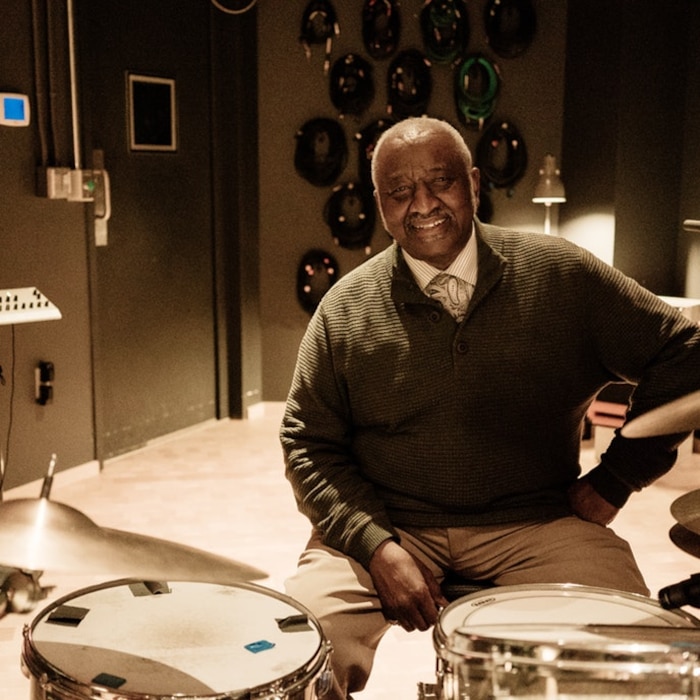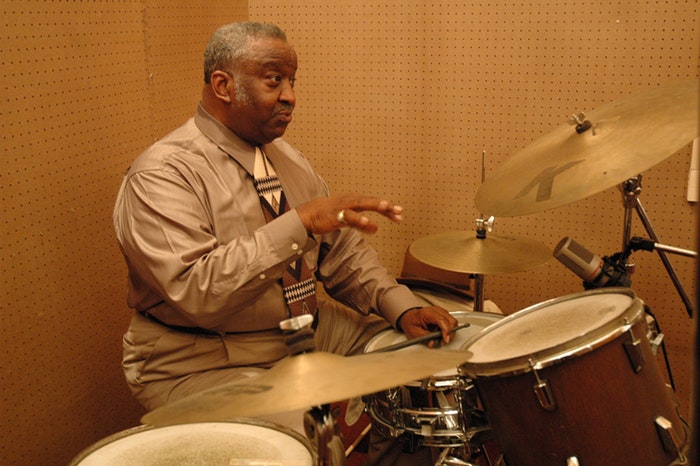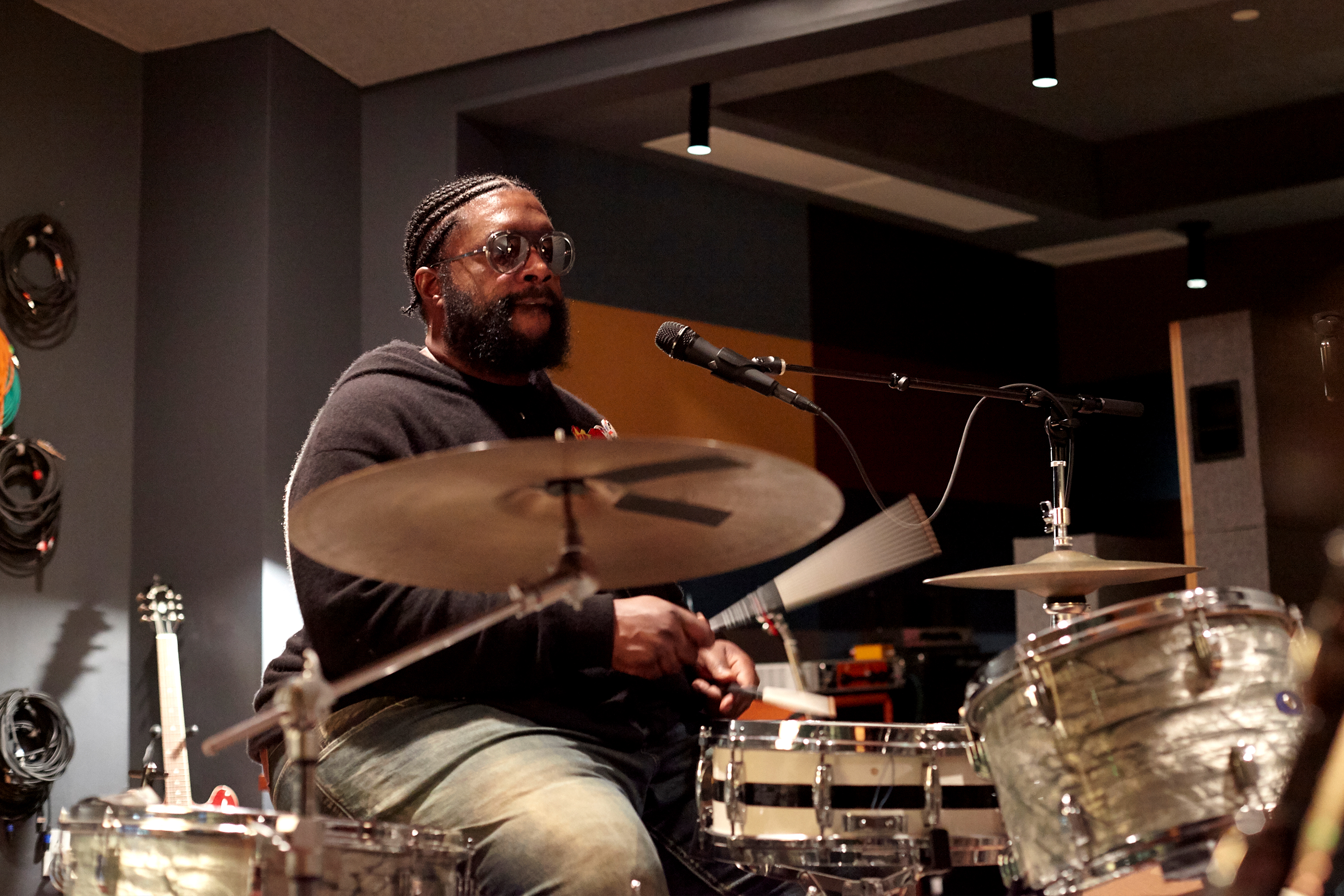Give the Drummer Some: Bernard Purdie
Known for hits with Steely Dan and Aretha Franklin, the iconic session drummer sits down with J-Zone to discuss his illustrious recording career

Renowned as “the world’s most-recorded drummer,” the great Bernard “Pretty” Purdie has lent his skills to classics by the likes of Aretha Franklin, James Brown, King Curtis & the Kingpins, Steely Dan, Daryl Hall & John Oates, Roy Ayers, Gil Scott-Heron and countless others over the course of an unprecedented career spanning five decades. Purdie’s peerless versatility has allowed him to move effortlessly between jazz, rock, pop, soul, funk and Latin, and his signature rhythmic invention, the Purdie Shuffle, is the indelible amalgamation of these myriad influences. In this edited excerpt from Red Bull Radio’s Give the Drummer Some with host J-Zone, Purdie recalls his tenure as Lady Soul’s music director and discusses his ultimate breaks and beats.
Your drum break in Aretha Franklin’s “Rock Steady” inspired everybody – DJs, drummers, producers – and it’s recognized as a high-water mark in funk drumming.
That was totally an accident. While we were in the studio doing it, she had the music on the piano while she was playing and the sheet music fell on the floor. Now, she started calling somebody, asking somebody to come in and get the music. Well, we just never stopped and she would just say, “Rock! Steady! Rock!”
Then, finally somebody was there to put the music back on the piano and that four-bar break had just happened. I just never stopped and I ended up with the four-bar and it turned out to be a lifeblood for me.
You were born and raised in Elkton, Maryland.
Elkton, Maryland is real... It’s a big city, but it is so country it’s pathetic. The nicest part is that it worked for me. Small Town, USA, and believe me, it was another world. But it was the biggest town in all of Cecil County where everybody came to get married. And on top of that, the Clyde Bessicks Orchestra played every Friday and Saturday night. So that’s where I learned to play with my teacher, Mr. Leonard Heywood.
Leonard Heywood actually played in the Clyde Bessicks Orchestra, right?
Yes, he was the drummer for the Clyde Bessicks Orchestra, but he was also the teacher and he actually allowed me to sit on the stoop while he was teaching others. I could grab everything immediately. That’s how good I was.
When did you have your first professional gig?
I was playing the big band by the time I was eight years old. I was covering for Mr. Heywood every Friday and Saturday night, setting up his equipment, doing everything, because by the break time, Mr. Heywood would actually go to his car and take a little nap.
I was the one carrying his water glass. It was full of either vodka or gin, so I would give him his water and then wait for him to go to the car because he would go to sleep every time. And at 12 AM, I’d be sitting on the drums finishing the gig.
It was the best thing in the world. By the time I was 12, I had my own little band.
So what year did you actually come to New York City?
1961 and it was the greatest thing in the world for me. In the first week that I got here, I met Mickey and Silvia and they asked me to play a recording session for them. Well, we recorded a whole album.
What was even more amazing, I got paid $80. That’s a month’s salary, man. And I spent it all that night with the band at the Comet Club. I bought everybody drinks. I bought the audience drinks. It was gone. It was amazing.
My job was always to give Aretha what she needed – every single time.
So around this time, the mid-’60s, you became known for this infamous sign that you would post by your drums. What was the motivation behind it?
I wish I could take the credit for having those signs made, but the credit goes to a bass player named Jimmy Tyrell. He said, “Purdie, because you’ve gotten so good at what you do, have signs made. They’ll remember you.”
I had three different signs made: “If you need me, call me. You have done hired the hit-maker;” so when I’d go someplace, more producers was telling the writers, “Hey, get the kid with the sign,” and that’s what they did.
And did the other musicians react a certain way to the signs?
Ah, yes. “Oh, man. He just brags about everything and blasé, this, and this.” I didn’t know diplomacy. Yes, I had a big mouth. But everyone that did listen became rich.
And that approach is what changed a lot of the rhythms in rhythm and blues, which eventually became funk drumming.
It sure did.
Coming from an era of a lot of traditional shuffles and twist beats, you came with this syncopated, eighth note-driven, left-hand action with a loose bass drum, and by the end of the ’60s, the rhythm on R&B entirely changed and the whole change was pretty much anchored by your playing on a lot of these sessions. Did you know you were revolutionizing the drumming?
If I’d have known what I had and what I was doing, that’ve been a whole different ballgame. Then, I would’ve gotten into the business part of the world much sooner.
What was your experience like working with James Brown? I know you recorded with him, but did you actually perform with him on the road?
Yes, I played on the road with James and it kicked my butt because at the time, we had two drummers and a percussionist.
One night, another drummer made a mistake when James was dancing and he called out a fine. He fined me $25. Now, I wasn’t making but $125 at the time anyhow. It was a lot of money and I didn’t make the mistake.
So when the night got finished, I went to Mr. Brown. I said, “Sir, I know that you know that it wasn’t me who made the mistake,’ and he said, “Oop, too late.” I said, “Oh. No, no, no. I’m not going to pay for somebody else’s mistake. ”
He looked at me and said, “Well, I’m the boss. I’m James Brown, so you do what I say.” I politely said to him, “Is this the end of it? Tell me now if you’re definitely fining me the $25,” and he said, “Yep, that’s it.” I said, “Then, you have my two weeks notice.” So that two weeks went by and I left.
One time you did make a mistake was your first encounter with King Curtis. You got on the bandstand, he called off “Sister Sadie,” and you weren’t quite ready. What happened with that first encounter with King Curtis?
“Sister Sadie” would be called and you better be ready. Well, I wasn’t ready because I didn’t know. By the time I actually sat down, 32 bars had gone by and then he turned and said, “Oop, you got it!” Uh, got what? “It’s time to solo,” and I blew it. I blew it big time. Crying and everything. It’s too late now. The damage was done, so I got to go back to the woodshed because I got to make sure that this never happens to me, again.
You eventually got another chance. And you went on to have a great working relationship with King Curtis – stuff like “Memphis Soul Stew,” which is iconic.
Not only was I doing the recordings, but what people did not know at all is that I also was his bookkeeper, especially on the road. I knew every penny of his money, where it came in and how it got distributed. He was showing me how to be a bandleader.
You also were instrumental in bringing the funk grooves to jazz, which was the beginning of what we know as soul-jazz with labels like Prestige, Flying Dutchman. You had a heavy presence in a lot of these sessions, so what was that like playing longer jazz songs where the band stretches out as opposed to these two and three-minute R&B cuts that you played on in the ’60s?
It was all about what they wanted. They made the choice of how long they wanted something or they would let it go. Everything I did was to build to the climax, and then back off and then do the next climax and take the song out.
I want to talk about the Latin funk that you played a huge role in. You played a great drum break on “Cold Sweat” with Mongo Santamaria, but Latin music, traditionally, didn’t have a trap drummer. So how did you get the trust of these artists and producers to sit there as an actual drum set player and add to the music?
Well, Mongo liked that I could fit in with his stuff and not take anything away from him. Latin, now, under normal circumstances, you got to be on top of the beat.
That’s the norm and that’s why these guys play what they play and their cowbell is always up. Well, I learned how to use a cowbell with a backbeat, just a slight lay back, so it didn’t get in the way of the congas being on top or the bongos being on top and being in the middle where the range of everything was so fat.
You were always able to play on any type of record or any style, but you were able to maintain your personality and signature as a drummer on everything you did. How did you manage to do both?
The reason that I do what I do is because of all of my good looks. When folks get too serious and get too uptight about what they’re saying and they can’t say something and they’re frustrated, I just tell them, I says, “Fellas, when you have that kind of problem, think about me and think about all of my good looks.” They laugh... and everybody relaxes, and I get everybody on the same page.
That skill of getting everybody on the same page came in handy as you were Aretha Franklin’s musical director for years.
Well, I didn’t become the musical director until Curtis passed. But I worked for Curtis for a good eight to 10 years, so I knew everything that was going on. I also knew what I had to do with Aretha. My job, my first job, was always to give her what she needed every single time. Every single time that she opened her mouth to sing, it was always there. I put my foot in it. That was my job.
You get the call to work with Steely Dan, who are known for being fussy, especially with drummers and they take a lot of takes in the studio. So what was it like to go from moving at a quick pace to having to play things over and over? Or did you just suggest things and they caught on right away?
Actually, both. I told them to play me the song. About two minutes into the song, I knew exactly what I was going to play and they said, “Well, what are you going to do?” I said, “I’m going to do the Purdie Shuffle.” “No, no, no, no! We don’t want none of this shuffle!” They said all the things and said what they had to. I said, “But you haven’t heard it yet.”
They didn’t know what was happening and when I finally picked up the sticks, they totally freaked out.
With all the session work that you’ve done, when you listen back on certain things, do you always know that it’s you playing? Can you instantly recognize your own playing?
No, because there are times when people want you to do something specifically and that’s what you do. That was part of the job. Do your job and let it go. Don’t get emotionally involved with people taking from you. That was the hard part for me.
But you know what? I don’t care anymore, I don’t worry about it anymore, and I don’t care if folks think that this is B.S. coming down the pipe. That don’t bother me either. I lived it and nobody can take that away from me. No one.

